
|
The Tanker market
in 2003
|
|
Crude
oil transport |
Freight market
VLCC
Suezmax
Aframax
Prospects
The second-hand market
VLCC
Suezmax
Aframax & Panamax
OBO
The outlook
see also : The
transport of refined oil products
|
|
At the end of 2002 certain
notorious events led one to believe that during 2003
freight rates risked experiencing a continuous
decline.
Thus, whilst the economic
climate remained morose within the industrialised
countries, the American intervention in Iraq seemed
inevitable. At the same time the Venezuelan crisis in
addition to the cut in production quotas by OPEC
members, made for a grim prospect for owners.
To reinforce this pessimism,
the impact of the 'Prestige' accident promised to lead
to a round of drastic measures for older vessels and to
further justify a policy of massive orders of
newbuildings.
As we shall see later in the
analysis of the different freight rates, the very
strong rises in the last quarter of 2002 carried
through into the first quarter of 2003 before beginning
a steady decline until the fourth quarter, which then
saw a strong rebound in freight rates across the board.
Consequently, as a whole, the year 2003 was
characterised by very firm average rates, often
approaching the records of 2000.
However on a global view, the
results of the past year are particularly mixed. Whilst
growth has remained extremely limited in Western
Europe, one has witnessed a distinct improvement within
the US during the second half.
Elsewhere, emerging countries such as China with a 7 to
8 % annual GDP growth, but also India, have today
become particularly influential countries and dominant
players in the realm of energy transport
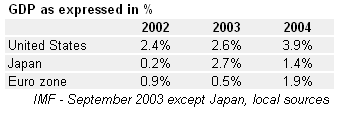
|
|
The development of freight rates
over the year |
|
As can be seen in the various
tables which follow, there has been a highly volatile
market. If 2002 can be seen to have had a sharp decline in
the first three quarters followed by a sharp rebound at the
end of the year, 2003 has been far more variable.
The first and last quarters were
characterised by a marked tightness in rates, whilst the
second quarter saw a progressive drop in activity and
levels, to the extent of reaching rock bottom prices during
the third quarter.
An analysis by sector helps to
understand the reasons of such variations, and will allow us
to try to make some short and medium term projections.
However, before studying in detail
each of the three principal categories of crude oil
transport, we should briefly examine the major change which
intervened within the chartering practices and which were
confirmed in 2003. The impact of the 'Prestige' incident has
definitively and radically transformed the attitude of
players in the market, even though the main owners had
largely modified the regulations since the 'Erika' incident:
with a more rigorous policy of selection ('vetting'), a
priority for double-hulled vessels, etc.
A number of producing and
consuming countries have also begun the process this year of
officially adopting these measures. As an example, countries
such as Tunisia, Algeria, and Morocco have suddenly switched
from a somewhat liberal chartering policy to a stricter
supervision and, as from now, will only accept vessels less
than 15 years old into their ports.
And finally the European
Community, largely bypassing the previous decisions of the
IMO in the progressive elimination of old vessels, has
forbidden as from October 21st single-hulled
vessels carrying fuel oil or heavy crude into its ports.
The combination of these measures,
bringing into line steps already taken by the US, only
serves to increase the gap with countries of the Middle East
and the Far East. As we shall see in our conclusion, this is
likely to be a temporary situation and we shall probably
witness a general uniformity of security measures in the
years to come.
|
|
|
The strong surge in
rates during the last quarter of 2002 was due to
several factors: the expected American
intervention in Iraq, the traditional period of
building up stocks, and the repercussions of the
'Prestige' story.
These factors prevailed
throughout the first quarter of 2003, before
beginning a steady decline at the end of the
advance of American troops in Iraq.
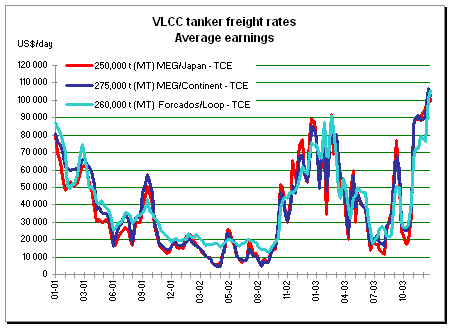
Freight rates then were
particularly affected during the summer with
returns below $20,000 per day, without however
hitting the lowest levels experienced in 2002.
As from September,
assisted by an increase in demand, an excess over
OPEC's production quotas and the restart of Iraq
exports from the Gulf, rates began to rise
strongly. Variations started to become erratic
with considerable fluctuations from week to week.
Consequently dependent on specific demand, one saw
levels changing within days from WS100 to WS52.5
for voyages to the West, then jumping to WS120 in
less than 10 days!
As a result, over the
whole of 2003 and on the three routes that we use
as reference, the average return of a modern VLCC
was $52,000 per day whereas it was only $22,500
per day in 2002.
We noticed a marked
increase in the trend already noted in our last
two reports, namely a shortening of voyages with a
smaller share of movements Middle East
Gulf / West, a strong increase in voyages Middle
East Gulf / East (and in particular to China) and
an increasing market share of movements from West
Africa, with again a greater proportion of traffic
moving East and notably to India.
With respect to the
evolution of the fleet, today we can count 445
VLCC / ULCCs, of which nearly 60% are less than 10
years old and are therefore double-hulled. 74 new
units are due to enter the fleet in the next 2
years.
Despite these figures
and the 'risk' of seeing orderbooks fill up again
in 2006, as we shall see in our conclusion, this
does not automatically imply a discrepancy between
supply and demand such as we have seen in previous
years'
|
|
|
The results of the past
year are similar in all respects for this category
of tankers to those of the larger size. Even if
the wild variations have not been so evident as
with the VLCCs, the fluctuation in the graphs
corresponds to the same factors.
In the wake of the last
quarter of 2002, the first three months of 2003
enjoyed strong levels before starting a steady
decline and reaching the bottom during the summer.
A sustained demand in transport across all
geographical zones during the last quarter saw
levels jump back up to record highs.
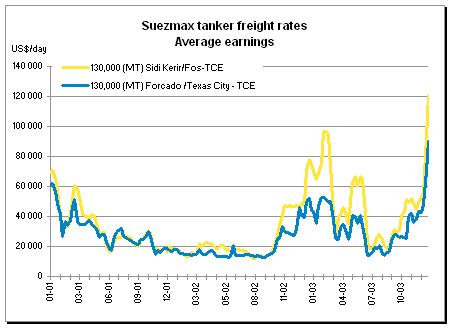
Even more than in
previous years, one can see evidence of the major
role played by the Mediterranean market. Despite
the temporary stoppage of Iraqi exports from the
Turkish terminal in Ceyhan, the share of movements
from the Black Sea has become preponderant and the
opening of new terminals has considerably
increased export volumes.
This recurrent new
phenomenon, the conditions imposed by the Turks
concerning the transit of the Dardanelles and the
Bosphorus, today distort the balance of this
market. Consequently with the coming of winter and
bad weather, the restriction of daily transits to
three units of more than 200 metres, for each
direction and for each of the two straits, results
in real bottlenecks. With the return voyage
stretching beyond 20 days in winter months, the
market is totally disrupted.
It is no longer just a
question of demand causing a rise in rates, but
purely and simply a matter of limited supply. This
artificial phenomenon also strongly affects the
Aframax market as we shall see later and can only
be resolved progressively with the coming into
service of oil pipelines feeding directly into the
Mediterranean.
Even though voyages are
relatively short, one can note a considerable
improvement in returns for owners. Thus, on a Sidi
Kerir/Fos voyage, the average rate for 2003 has
been WS153 for an equivalent time charter rate of
$50,600 per day. By comparison the levels were
only WS102 and $27,475 per day over the period
2001/2002.
The major role played by
VLCCs today in West African exports, makes this
market somewhat hazardous for Suezmax owners.
Nonetheless, the American economic recovery has
allowed for an increase in movements and rates at
the end of the year. This has helped stop the drop
in freight rates seen in the 2nd and 3rd
quarters and to produce an average annual rate of
WS135 for a West Africa/Gulf of
Mexico movement,
with an equivalent time charter of $35,000 per day
(respectively WS110 and $29,830 in 2001, and WS79
and $18,270 in 2002.)
The other notable
phenomenon has been a strong rise in demand for
such sizes out of the Middle East Gulf. Faced with
a temporary shortage of VLCCs at the end of the
year and healthy freight rates, some owners even
went to the point of dividing cargoes into two
lots of 1 million barrels. On voyages to the Far
East, rates for modern vessels went up to around
WS165/170, whereas for the same period in 2002
levels were WS100/110.
|
|
|
The Aframax category has
also largely benefited from the overall good level
of activity and has registered throughout all
geographical zones freight rates well in excess to
those of the previous year.
In the European zones
(North Sea and Mediterranean), the confirmation of
tighter security measures taken both by the
charterers as well as the governments themselves
has largely contributed to this improved
situation.
Once again, we can
observe a general evolution of rates in line with
those of the larger categories. The only critical
period for owners was during the summer with daily
returns averaging around $10,000 per day. However,
on the two voyage routes as shown in the hereafter
graph, one can see that the average return for a
modern vessel was $42,300 per day over the year.
In respects to the North
Sea market, it is important to point out the
preponderant role played by Russian exports out of
the Baltic. As this is a zone particularly subject
to ice conditions in winter, the few ships, which
carry the classification norms of 1A and 1B, help
push the rates to extreme levels and have a
knock-on effect for all other movements.
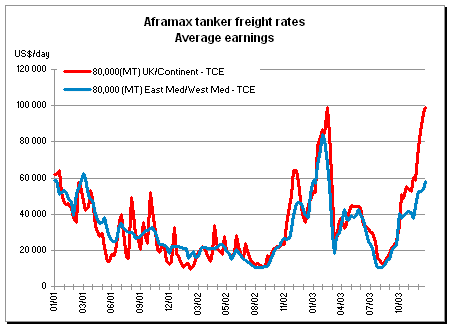
The Mediterranean
market, as for the North Sea, is largely dominated
today by the presence of modern double-hulled
vessels (more than 85% of ships regularly in this
zone). The older tankers, if they have not been
demolished or sent East of Suez, are still
chartered by certain Russian companies (but for
how long now?).
If a balance between
supply and demand remains a critical objective in
order to judge the level of a market, one must
nonetheless note the growing consequences of the
measures taken by the Turkish government on the
question of the transit of their straits. Thus, in
parallel with a strong increase in demand for
exports from the Black Sea, the phenomenon of
saturation in movements around end 2002 / early
2003 was again experienced as from October 2003.
The resulting delays tend to increase the
movements out of North Africa and, taking
advantage of the artificial shortage of tonnage,
owners rack up substantial profits'
The Caribbean market
remains closely linked with the economic situation
of the US. On the typical 70,000 tons movement
Caribbean/Gulf of Mexico, the market which was at
its lowest at the beginning of the year, reacted
very quickly to the Iraqi and Venezuelan crisis
during February and March, to hit very high
levels, WS395 for an equivalent time charter of
$73,750 per day and then plunged rapidly. As for
other size of tankers, the summer months were
particularly dull and rates plummeted to average
only $18,000 per day during the months of July and
August. The effect of the American economic
revival at the end of the year had an immediate
effect on rates, which have hardly stopped rising
right up to the end of the year.
Finally, on the Middle
East Gulf / Far East movements, the predominance
of old vessels weighs down on freight rates. Only
the influence of the strong rise in rates which
VLCCs and Suezmaxes established at the end of the
year, enabled average levels to improve and to
reach WS167 or $27,400 per day for the whole of
2003.
|
|
Short and
medium term prospects |
|
It is worth noting that
despite strong increases in rates, which owners have
been enjoying in 2003, this has not incited them to
abandon the spot market to engage in longer term
contracts.
For example, one can estimate
that for modern vessels during the last quarter, the
minimum rate required for a 2 year time-charter would
work out as follows: VLCC $32,000 per day, Suezmax
$25,000 per day, and Aframax $22,000 per day.
As a consequence of the
improvement in rates to some extent, but above all of
the rejuvenation of the fleet, the figures for
scrapping are lower than the two previous years.
|
|
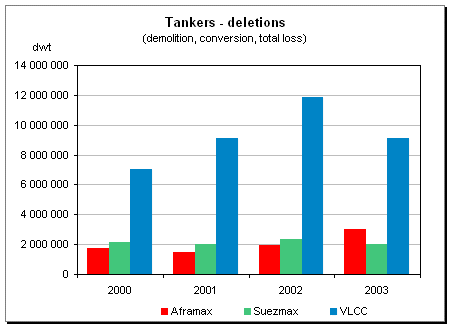
|
|
Numerous observers might
believe that because orderbooks are full up to 2006,
there is a risk of imbalance and consequently a
potential fall in rates. Between 2004 and 2006, 74
VLCCs, 70 Suezmaxes, and 151 Aframaxes should enter the
fleet.
Despite these figures we
believe that at least up until 2006, average freight
levels should not suffer substantial drops.
Outside the impact of global
economic factors and the probable evolution of energy
needs, two items in particular lead us to believe that
such a prospect is justified:
The dramatic accident of the
'Tasman Spirit' in Karachi, even if no responsibility
can yet be objectively placed on the vessel itself,
will almost certainly have consequences on the overall
control of tanker movements within this geographical
zone.
Being increasingly conscious
of the maritime safety measures already adopted by
Americans and Europeans, a good number of countries in
the Middle East and Far East today are beginning to
realise the extent to which they are burdened by a high
proportion of old vessels. One should therefore expect
to see the introduction of stricter measures on
maritime security in this area in the months to come.
Thus, a not negligible number of new ships will tend to
stay in these zones replacing the older ones, which
will be scrapped.
In conjunction with this
situation, it is interesting to compare the figures,
indisputably impressive, of the renewing of the world
fleet with the evolution of stricter chartering
policies, which are being imposed on market players. If
we take into account the evolution of the main
criterion of choice of charterers, we can compare, in
following graph, the evolution of what we can qualify
as 'eligible fleet'.
At the end of 1998, the
principal charterers only applied one criterion of age
(25 years old) in order to eliminate, in theory, ships
at most risk. From the end of 2000 till the end of
2002, this age limit was reduced to 15 years. As from
2004 the main charterers are only prepared to be
involved in double-hulled units.
This graph speaks for itself
and shows that the programmes for a massive renewal of
the fleet does not, for the moment, pose a major risk
on the imbalance of the market. As a result, with the
exception of the Aframax fleet, which will recover a
very high level by the end of 2006, the growth of the
whole of the 'eligible fleet' remains relatively
moderate with regard to the foreseeable growth in
demand.
|
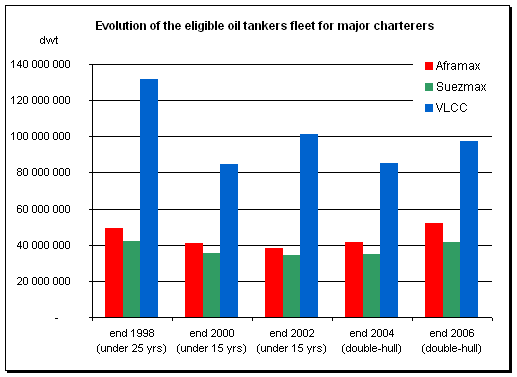
|
|
If one adds to these
objective criteria the probable prospects of an
increase in the energy needs, notably of the emerging
countries, nothing prevents one from being able to
contemplate a favourable climate for owners prevailing
for the next two to three years.
|
Shipping and Shipbuilding Markets in 2003
I N D E X
|